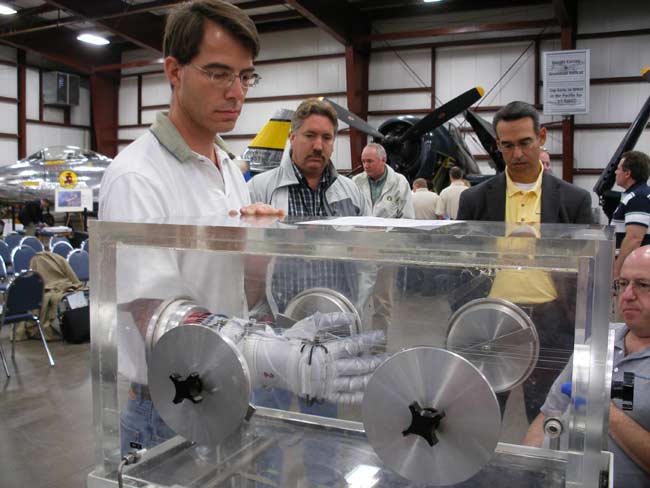Homemade Space Glove Wins NASA Contest

WINDSORLOCKS, Conn. -- An astronaut glove stitched together on a Maine engineer'sdining room table won a cool $200,000 Thursday in a NASA competition.
PeterHomer, an engineer from Southwest Harbor, Maine, won NASA's first-ever AstronautGlove Challenge after a two-day competition here at the New England Air Museum near Bradley International Airport.
"It feelsgood," said Homer, whose two home-built spacesuit gloves beat entries from twoother teams to take home the top prize. "It took a lot of sitting at the sewingmachine."
A total of$250,000, split into two separate prizes, was up for grabs during NASA'sAstronaut Glove Challenge, one of several Centennial Challenges offered by thespace agency to spur interest and innovation in spaceflight technology. Entrantswere charged with constructing spacesuit gloves capable of meeting, orexceeding, the specifications of NASA's current Phase VI glove. Of six possiblecontenders, three teams presented their gloves for the competition.
"If you'relooking for innovative ideas, evolutionary steps and better gloves, you can'tbeat it," Bill Spenny, shuttle spacesuit subsystems manager at NASA's Johnson Space Center, said of the Astronaut Glove Challenge told SPACE.com betweentests.
The smaller$50,000 award, reserved for any team to successfully demonstrate a MechanicalCounter Pressure glove that protects its wearer without using a pressurizedbladder akin to those found in current spacesuits, went unclaimed and willrollover to next year, event organizers said.
We havea winner
Breaking space news, the latest updates on rocket launches, skywatching events and more!
Homer'sprize marks the first time NASA has doled out a cash prize under its CentennialChallenges program despite five previous meets over the last two years. Thespace agency's separate Power Beam andTether challenges, held annually in 2005 and 2006, have twice ended withoutwinners. The NorthropGrumman Lunar Lander Challenge also went unclaimed last year.
"The fingermobility is the thing that I thought was most critical," Homer said of hisDacron-covered glove, which featured blue, off-the-shelf kitchen cleaninggloves for internal bladders. He attended the glove contest with his 14-year-old son Matthew.
To win the spaceglove challenge, teams submitted two prototypes -- one for demonstration andthe other for destruction -- for a barrage of endurance challenges. Those testsincluded dexterity measurements, flexibility checks and a burst test thatpumped one glove from each team full of water until it reached its breakingpoint.
Homer'sglove won out over an entry by the three-person team MDLH, which includedspacesuit mobility expert Gary Harris, aerospace engineer Pablo de Leon and Nik Moiseev, who until2005 served as engineer with the Russian firm Zvezda that designed thatcountry's current and Soviet-era spacesuits.
"We'reinterested to know what the differences were between the gloves," de Leon told SPACE.comafter Homer's victory, adding that his team may compete in next year's contest."We came to this competition knowing what the chances were."
ArtistTheodore Southern, of Brooklyn, New York, also entered a seamless glove made ofpolyurethane with internal fabric layers, though the design failed to pass amandatory burst test early in the two-day competition.
"Each ofthe entries was very different, very unique," said Alan Hayes, CEO of the Owings,Maryland-based Volanz Aerospace that oversaw the competition for NASA. "And youwant something out of the box."
The contest marked the first of a three-year series of NASA Astronaut Glove Challenges. A $350,000 purse is slated for awards in 2008, with $400,000 available in 2009, NASA said.
Phase VIand beyond
NASA'scurrent spacesuit glove, the PhaseVI unit built by Hamilton Sundstrand and ILC Dover, sports adjustablefingers with their own heaters and is designed to attach to the agency'sExtravehicular Mobility Unit (EMU) spacesuit via wrist joints.
DavidGraziosi, a spacesuit design engineering manager at ILC Dover, said new glovesare custom tailored to their specific astronauts.
Despitepains taken to ensure performance and comfort, working long hours in whatfundamentally is a pressurized balloon can be grueling on the hands and body,astronauts said.
"It's moreimportant to have a good fit that's not going to hurt you," astronaut MikeMassimino, who performed two spacewalks during NASA's STS-109 mission toservice the Hubble Space Telescope, told SPACE.com. "If you get them tootight, you can do damage to your hands."
Massiminois training for NASA's next, and final, Hubble servicing mission to fly in2008. Working with the Phase VI glove, like toiling in a spacesuit in general,can be tiring due to the physical demands of fighting a stiff spacesuit filledwith air to perform tasks in Earth orbit. Tight grips on handrails, forexample, can tire an astronaut's hands out unnecessarily since only lighttouches are need during spacewalks.
"You onlyneed a fingertip touch," Massimino said. "The glove could tire out your handsif you let it."
Meanwhile,NASA officials and space hardware competitors are gearing up for anotherCentennial Challenge on May 12 -- this time in Santa Maria, California -- whereentrants are expected to showcase robotic digging machines.
Thatcompetition, the 2007 Regolith Excavation Challenge, calls for competitors todemonstrate machines capable of autonomously digging through mock lunar surfacematerial during a preset time limit.
- VIDEO: Contenders for the 2007 Lunar Lander Challenge
- X-Prize Space Elevator Race Ends With No Winners
- Top Contender for Lunar Lander Prize Crashes

Tariq is the award-winning Editor-in-Chief of Space.com and joined the team in 2001. He covers human spaceflight, as well as skywatching and entertainment. He became Space.com's Editor-in-Chief in 2019. Before joining Space.com, Tariq was a staff reporter for The Los Angeles Times covering education and city beats in La Habra, Fullerton and Huntington Beach. He's a recipient of the 2022 Harry Kolcum Award for excellence in space reporting and the 2025 Space Pioneer Award from the National Space Society. He is an Eagle Scout and Space Camp alum with journalism degrees from the USC and NYU. You can find Tariq at Space.com and as the co-host to the This Week In Space podcast on the TWiT network. To see his latest project, you can follow Tariq on Twitter @tariqjmalik.
